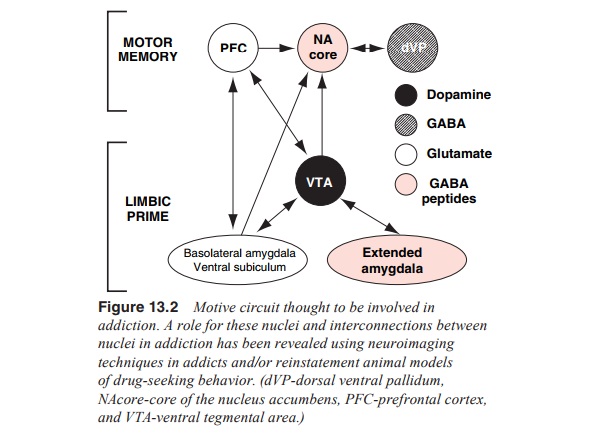Chapter: Essentials of Psychiatry: Psychiatric Pathophysiology: Addiction
Psychiatric Pathophysiology: Addiction

Psychiatric Pathophysiology: Addiction
Addiction is a complex maladaptive behavior
produced by re-peated exposure to rewarding stimuli (O’Brien, 2001). There are
two primary features common to both natural and pharmacologi-cal stimuli that
elicit addiction. First, the rewarding stimulus as-sociated with the addiction
is a compelling motivator of behavior at the expense of behaviors leading to
the acquisition of other rewarding stimuli. Thus, individuals come to orient
increasing amounts of their daily activity around the acquisition of the re-warding
stimulus to which they are addicted. Secondly, there is a persistence of
craving for the addictive stimulus, combined with an inability to regulate the
behaviors associated with obtaining that stimulus. Thus, years after the last
exposure to an addictive stimulus, re-exposure or environmental cues associated
with that stimulus will elicit behavior aimed at obtaining the reward.
During the course of repeated exposure to strong
motiva-tionally relevant stimuli, specific brain nuclei and circuits become
engaged that mediate the addicted behavioral response. It is gener-ally thought
that different rewarding stimuli involve different brain circuits, but also
that there are regions of overlap forming a common substrate for all addictive
stimuli. Studies using animal models of re-ward and addiction have focused on
subcortical brain circuits known to be involved in drug reward, such as the
dopamine projection from the ventral mesencephalon to the nucleus accumbens
(Koob and LeMoal, 2001; Everitt and Wolf, 2002). Accordingly, molecular and
electrophysiological studies of the cellular plasticity mediating the emergence
of addictive behaviors have focused on the nucleus ac-cumbens and ventral
mesencephalon. However, over the last decade studies have emerged from both the
animal literature and neuroim-aging of drug addicts indicating that the
expression of addicted be-haviors such as sensitization and craving involves
regions of the cor-tex and allocortex (Pierce and Kalivas, 1997; Volkow and
Fowler, 2000; Grant et al., 1996;
Childress et al., 1999). In this
regard, two regions have come to be most closely associated with craving, the
amygdala and frontal cortex (including the anterior cingulate and ventral
orbitofrontal cortex). Prior to describing circuitry underly-ing the state of
addiction, we will briefly examine the neurobiology associated with the
development of the addicted state.
Related Topics